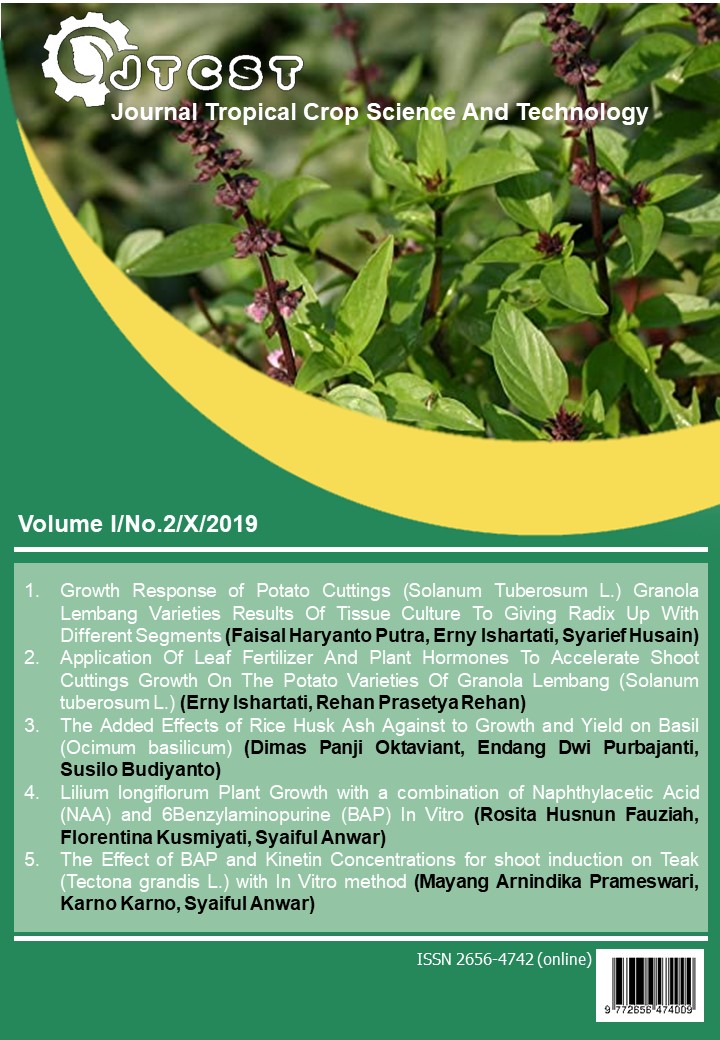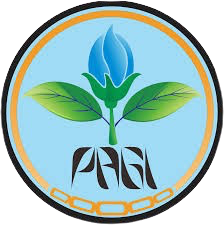Growth Response of Potato Cuttings (Solanum Tuberosum L.) Granola Lembang Varieties Results Of Tissue Culture To Giving Radix Up With Different Segments
DOI:
https://doi.org/10.22219/jtcst.v1i2.9991Keywords:
Rootone F, Radix Up, SegmentsAbstract
Potato plants are propagated vegetatively with tubers. The difficulty of getting potato seeds with tubers is an obstacle in the supply of potato seeds, to overcome these obstacles vegetative propagation with cuttings can be a solution for the supply of potato seeds. This research used a factorial Randomized Block Design (RBD). The first factor is the type of Radix Up consisting of 4 levels, namely Z0 (control), Z1 (Radix Up 1), Z2 (Radix Up 2), and Z3 (Radix Up 3), the second factor is the number of segments consisting of 3 levels namely D1 (number of segment 1), D2 (number of segment 2), and D3 (number of segment 3). Observation variables included: when the roots appeared, plant height, number of leaves, and stem diameter. The results showed that there was an interaction between Radix Up types and the number of segments on the growth of potato shoot cuttings when the roots appeared, but there were no interactions on other observational variables. The Z1D3 treatment (Radix Up 1 and segment number 3) gives the fastest average value, which is the average when the root appears 4.33 days.
Downloads
References
Ardaka, I M., I G. Tirta and D. P. Darma. 2011. Effect of the number of segment and growth regulating substances on the growth of Pranajiwa cuttings (Euchresta horsfieldii (Lesch.) Benth.). Journal of Plantation Forest Research 82 Vol.8 No.2: 81 – 87.
Astutik. 2007. Study of the Effect of Growth in the Development of Chrysanthemum Tissue Culture. Buana Science Vol 7 No 2: 113121.
Campbell, N. A and J. B. Reece. 2012. Biology. Penerbit : Benjamin Cummings. San Fransisco.
Fahmi, L. S., R. Sipayung, dan Meiriani. 2017. Effect of cuttings and provision of NAA ZPT on growth of Britton & Rose's Red Dragon Fruit Seedlings (Hylocereusn Costaricensis (Web) Britton & Rose). Journal of Agroecotechnology Faculty of Agriculture USU. Vol.5. No.2 (38): 284- 297.
Lakitan, B. 2000. Physiological Growth and Development of Plants. Publisher of PT Raja Grafindo Persada, Jakarta.
Suyadi and Maryana. 2015. Successful Growth of Cured Seedlings in the Use of Various Amounts of Stem Cuttings and Time of Stabbing. Yogyakarta PGRI University. ISBN 978-602-73690-3-0
Ummah, K., and A. Purwito. 2009. Potato Cultivation (Solanum tuberosum, L.) with Special Aspects of Nurseries at Hikmah Farm, Pangalengan, Bandung, West Java. Paper presented at the confrence of the Department of Agronomy and Horticulture, Faculty of Agriculture IPB. Bogor.
Usrial, M., M. Mardhiansyah, dan T. Arlita. 2016. Response of Plant Growth Regulator (PGR) with Active Substances Naphthalene Acetic Acid (NAA) Against Growth of Stubble Cuttings from Stump Remaining Eucalyptus Pellita. Jom Faperta Vol.3 No.1
Downloads
Published
How to Cite
Issue
Section
License
Copyright (c) 2019 Faisal Haryanto Putra, Erny Ishartati, Syarief Husain

This work is licensed under a Creative Commons Attribution-ShareAlike 4.0 International License.
Authors who publish with this journal agree to the following terms:
- Authors retain copyright and grant the journal right of first publication with the work simultaneously licensed under a Creative Commons Attribution License that allows others to share the work with an acknowledgement of the work's authorship and initial publication in this journal.
- Authors are able to enter into separate, additional contractual arrangements for the non-exclusive distribution of the journal's published version of the work (e.g., post it to an institutional repository or publish it in a book), with an acknowledgement of its initial publication in this journal.
- Authors are permitted and encouraged to post their work online (e.g., in institutional repositories or on their website) prior to and during the submission process, as it can lead to productive exchanges, as well as earlier and greater citation of published work (See The Effect of Open Access).











